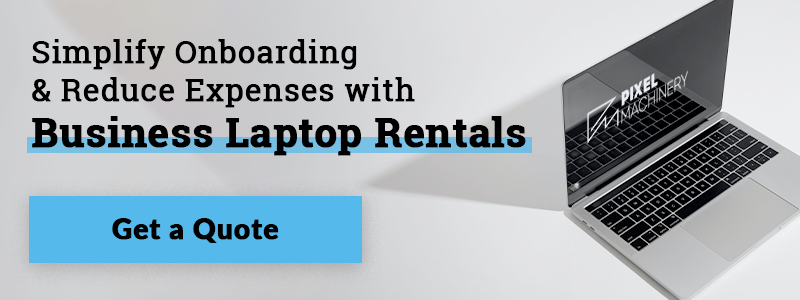Business Computer Leasing vs. Purchasing Outright
Whether for new workers, temporary workers, or remote workers, businesses often have to provide a fleet of laptops to the people who work for them. The dilemma often boils down to leasing computer equipment or purchasing it outright.
Both approaches come with their sets of advantages and drawbacks, depending on the specific needs, financial position, and future goals of a business. This article will explore the pros and cons of each method, helping decision-makers choose the best fit for their organization.
Understanding Computer Leasing
Leasing refers to businesses obtaining computer equipment in exchange for regular payments over a predetermined period. It's akin to renting a house; you fully use the equipment without actually owning it.
Pros of Leasing
Up-to-date Technology: Leasing agreements often include upgrades, ensuring businesses can always access the latest technology.
Fast delivery: Many leasing companies have a fleet of devices ready to ship within days.
Cash Flow Management: Rather than a significant upfront cost, businesses can manage their finances with predictable monthly expenses.
Tax Benefits: Leased computers don’t need to be deprecated, and payments are deducted as a business expense, potentially reducing tax liabilities.
Flexibility: At the end of a lease term, businesses can choose to upgrade, extend the lease, or return the equipment, giving them more flexibility than outright ownership.
Cons of Leasing
Total Cost: Over time, leasing can become more expensive than purchasing equipment outright, especially if the lease is extended multiple times.
Contractual Obligations: Businesses are tied into lease agreements, which might include early termination fees.
No Ownership: At the end of the lease, unless there's a buyout clause, the business doesn't own the equipment.
Understanding Purchasing Outright
Purchasing outright, as its name suggests, involves a one-time, upfront investment allowing a company to claim full ownership of the equipment immediately. This approach has been the traditional route for many businesses over the years. Beyond the simplicity of ownership, there are other nuances and implications to consider.
Pros of Purchasing Outright
Asset Ownership: The business owns the equipment, adding to the company's assets and overall value.
Cost-Effective in the Long Run: Over a more extended period, purchasing can be more economical than leasing, especially if the equipment has a long useful life.
No Contractual Obligations: Businesses aren't tied down to usage terms or length of use.
Depreciation Benefits: Purchased equipment can be depreciated over its useful life, offering potential tax benefits.
Cons of Purchasing Outright
Upfront Costs: A significant initial investment is required, which might not be feasible for some businesses, especially startups.
Technology Obsolescence: As technology advances rapidly, owned equipment can become outdated, potentially putting businesses at a competitive disadvantage.
Lack of Flexibility: If the business needs to scale down or switch technologies, owned equipment can become a liability.
Factors to Consider When Making a Decision
Budgetary Constraints: Can the business afford the upfront cost of buying, or are monthly lease payments more manageable?
Technology Lifespan: Will the technology remain relevant for the foreseeable future, or will it need frequent updating?
Financial Implications: Consider the tax implications of both options, as well as the impact on cash flow and balance sheets.
Operational Flexibility: Does the business require the flexibility to upgrade frequently, or is long-term stability more crucial?
Growth Projections: Rapidly expanding businesses might prefer the flexibility of leasing to scale their operations seamlessly.
Case Studies: A Real-world Example
Temporary healthcare workers
Consider a company that hires traveling healthcare personnel. By leasing, the company ensured every healthcare worker had access to the latest healthcare software, simplifying IT management for short-term staff. Additionally, this approach allowed for short delivery times, consistent communication across locations, predictable budgeting, and tax benefits.
Established accounting firm
Conversely, a well-established accounting firm with a substantial budget and a need for long-term, stable workstations might opt to purchase computers outright, ensuring stability and long-term cost savings.
Related Content: Cost Breakdown of Laptop Rentals For Business
Takeaways
Leasing offers benefits such as access to the latest technology, predictable monthly expenses, and tax benefits, but may incur higher long-term costs and lacks ownership at the end of the lease term.
Conversely, purchasing outright provides immediate ownership and can be cost-effective over time, but requires a substantial upfront investment and poses the risk of technology obsolescence.
Various factors, including budget, technology lifespan, financial implications, operational flexibility, and growth projections, should be considered when making this decision. The article also provides real-world examples to illustrate the benefits of each option for different business contexts.
- Leasing Computers:
- Pros: Access to up-to-date technology, predictable monthly expenses, tax benefits, flexibility in terms, and quick delivery.
- Cons: Can be more expensive long-term, contractual obligations, and lack of ownership at the end of the term.
- Purchasing Computers Outright:
- Pros: Immediate asset ownership, potential long-term cost savings, no usage constraints, and tax benefits from depreciation.
- Cons: Significant upfront investment, risk of technology becoming obsolete, and reduced operational flexibility.
- Decision-making Factors:
- Consider budget, tech lifespan, financial implications, operational needs, and company growth projections.

